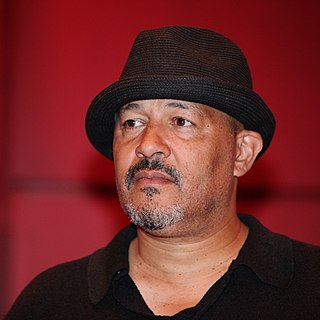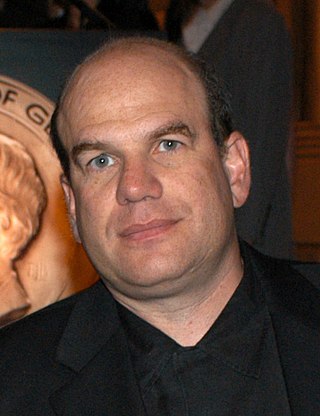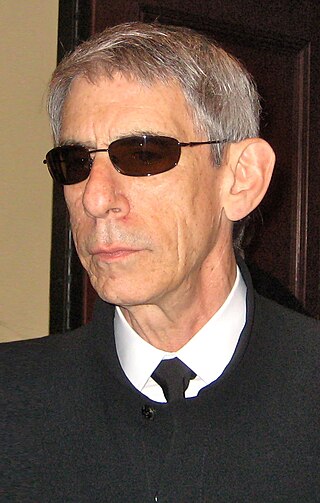Related Research Articles

Barry Lee Levinson is an American film director, producer and screenwriter. Levinson won the Academy Award for Best Director for Rain Man (1988). His other best-known works are similarly mid-budget comedy drama and drama films such as Diner (1982), The Natural (1984), Good Morning, Vietnam (1987), Bugsy (1991), and Wag the Dog (1997). In 2021, he co-executive produced the Hulu miniseries Dopesick and directed the first two episodes.
Homicide: Life on the Street is an American police drama television series chronicling the work of a fictional version of the Baltimore Police Department's Homicide Unit. It ran for seven seasons and 122 episodes on NBC from January 31, 1993, to May 21, 1999, and was succeeded by Homicide: The Movie (2000), which served as the series finale. The series was created by Paul Attanasio and based on David Simon's book Homicide: A Year on the Killing Streets (1991). Many of the characters and stories used throughout the show were based on events depicted in the book.

Clark Johnson is an American-Canadian actor and director who has worked in both television and film. He is best known for his roles as David Jefferson in Night Heat (1985–1988), Clark Roberts in E.N.G. (1989–1994), Meldrick Lewis in Homicide: Life on the Street (1993–1999) and Augustus Haynes in The Wire (2008). He is an Emmy Award and two-time Genie Award nominee.

Tom Fontana is an American screenwriter, writer, and television producer. Fontana worked on NBC's Homicide: Life on the Street and created HBO's Oz.

David Judah Simon is an American author, journalist, screenwriter, and producer best known for his work on The Wire (2002–2008).
John Munch is a fictional character played by actor Richard Belzer. Munch first appeared on the American crime drama television series Homicide: Life on the Street on NBC. A regular through the entire run of the series from 1993 to 1999, Munch is a cynical detective in the Baltimore Police Department's Homicide unit, and a firm believer in conspiracy theories. He is originally partnered with Detective Stanley Bolander. Munch is based on Jay Landsman, a central figure in David Simon's 1991 true crime book Homicide: A Year on the Killing Streets.

Richard Jay Belzer was an American actor, comedian, and author. He was best known for his role as BPD Detective, NYPD Detective/sergeant and investigator John Munch, whom he portrayed for 23 years in the NBC police drama series Homicide: Life on the Street, Law & Order: Special Victims Unit and several guest appearances on other series.

The first season of Homicide: Life on the Street, an American police procedural drama television series, originally aired in the United States on NBC between January 31 and March 31, 1993. The show was created by Paul Attanasio, with film director Barry Levinson and television writer and producer Tom Fontana serving as executive producers. Adapted from David Simon's 1991 non-fiction book Homicide: A Year on the Killing Streets, the season followed the fictional detectives of Baltimore Police Department homicide unit and the murder cases they investigate. The show was broadcast on Wednesdays at 9 p.m. EST, with the exception of the series premiere, which aired immediately after Super Bowl XXVII.

The second season of Homicide: Life on the Street, an American police procedural drama television series, originally aired in the United States between January 6 and January 27, 1994. Due to low Nielsen ratings during the first season, NBC executives decided to order only a four-episode season, after which they would evaluate the ratings and decide whether to renew the show. Homicide was moved to a new timeslot of Thursdays at 10 p.m. EST, temporarily replacing the legal drama L.A. Law. NBC requested several changes from the series, including fewer episode subplots and less camera movements and jump cuts.
Alexander Zakrzewski is an American television director and cinematographer. He has directed episodes of Cold Case, Law & Order: Criminal Intent, Law & Order: Special Victims Unit, Numb3rs and The Wire, as well as worked on several Tom Fontana produced shows including Homicide: Life on the Street, Oz and The Jury. Prior to his episodic work, he shot documentaries for independent film makers and the US Networks including several for Harpo Productions, where he developed a reputation for fluid hand held work.

"Subway" is the seventh episode of the sixth season of the American police television drama Homicide: Life on the Street, and the 84th episode overall. It first aired on NBC in the United States on December 5, 1997. In the episode, John Lange becomes pinned between a Baltimore Metro Subway train and the station platform. The Baltimore homicide department is informed that Lange will be dead within an hour and Pembleton tries to solve the case while comforting Lange in his final minutes.

"Gone for Goode" is the first episode of the first season of the American police drama television series Homicide: Life on the Street. It originally aired on NBC in the United States on January 31, 1993, immediately following Super Bowl XXVII. The episode was written by series creator Paul Attanasio and directed by executive producer Barry Levinson. "Gone for Goode" introduced regular cast members Daniel Baldwin, Ned Beatty, Richard Belzer, Andre Braugher, Wendy Hughes, Clark Johnson, Yaphet Kotto, Melissa Leo, Jon Polito, and Kyle Secor.

"Three Men and Adena" is the fifth episode of the first season of the American police drama television series Homicide: Life on the Street. It originally aired on NBC in the United States on March 3, 1993. The episode was written by executive producer Tom Fontana and directed by Martin Campbell. In the episode, Pembleton and Bayliss have a 12-hour limit to elicit a confession from Risley Tucker for the murder of 11-year-old Adena Watson. The episode takes place almost entirely within the confines of the police interrogation room with the three actors.

"A Shot in the Dark" is the fourth episode of the first season of the American police drama television series Homicide: Life on the Street. It originally aired on NBC in the United States on February 24, 1993. The teleplay was written by Jorge Zamacona based on a story by executive producer Tom Fontana, and the episode was directed by Bruce Paltrow. In the episode, Crosetti focuses his investigation into the shooting of Officer Thormann on one suspect, while Lewis continues to investigate. Meanwhile, Pembleton and Bayliss pursue different leads in the murder case of 11-year-old Adena Watson.

"A Dog and Pony Show" is the sixth episode of the first season of the American police drama television series Homicide: Life on the Street. It originally aired on NBC in the United States on March 10, 1993. In the episode, Pembleton and Bayliss investigate the murder of a police dog, Crosetti helps his friend adjust after a serious injury, and Felton and Howard suspect a drug dealer for a brutal murder.
Jim Finnerty is an American television producer. He worked on all seven seasons of the NBC police drama Homicide: Life on the Street. He often works with Homicide executive producer Tom Fontana. He also worked on HBO's Oz.

"Payback" is the pilot episode of the police procedural television series Law & Order: Special Victims Unit, the first spinoff of the original Law & Order series. It originally aired on NBC in the United States on September 20, 1999. In the episode, the detectives of the Special Victims Unit investigate a taxi-cab driver's brutal murder and castration. Detective Olivia Benson becomes personally involved in the case after discovering that the taxi driver was a rapist and murderer himself.
Julie Martin is an American television writer and producer. She has worked on the NBC crime dramas Homicide: Life on the Street, Law & Order: Criminal Intent, Law & Order and Law & Order: Special Victims Unit. She won a Humanitas Prize and was nominated for a Writers Guild of America Award for her work on Homicide. She has also been nominated for an Edgar Award for her work on Criminal Intent.
"Black and Blue" is the third episode of the second season of the American police drama television series Homicide: Life on the Street, and the twelfth overall episode of the series. It originally aired on NBC in the United States on January 20, 1994. In the episode, Pembleton aggressively investigates what he believes to be a police-related shooting. Amid pressure from Gee to pursue civilian suspects, Pembleton elicits a successful confession from an innocent man, leaving Gee feeling conflicted. Directed by Chris Menaul, the episode's teleplay was written by James Yoshimura based on a story by series executive producer Tom Fontana.
"Nearer My God to Thee" is the third season premiere of the American police drama television series Homicide: Life on the Street, and the fourteenth overall episode of the series. It originally aired on NBC in the United States on October 14, 1994. In the episode, the homicide department is assigned to the politically volatile murder of a beloved social worker, whose body is found wearing nothing but a pair of white gloves. Meanwhile, Felton struggles with marital problems, while Lewis and Munch try to find a business partner with whom to open a bar.
References
- ↑ Hontz, Jenny (April 30, 1999). "Viacom gets the 'Beat'". Variety . Retrieved June 24, 2018.
- ↑ Gibbons, Kent (August 27, 2012). "After 'Homicide,' Before 'Copper,' Fontana, Levinson Walked a 'Beat'". Multichannel News . Retrieved June 24, 2018.
- ↑ Speier, Michael (March 20, 2000). "The Beat". Variety . Retrieved August 10, 2021.
- ↑ Pierce, Scott D. (April 11, 2000). "Just what is Levinson's 'Beat' role?". Deseret News . Archived from the original on June 25, 2018. Retrieved June 24, 2018.
- ↑ Cardace, Sara (June 27, 2007). "That's Detective Munch to You". New York . Retrieved June 24, 2018.